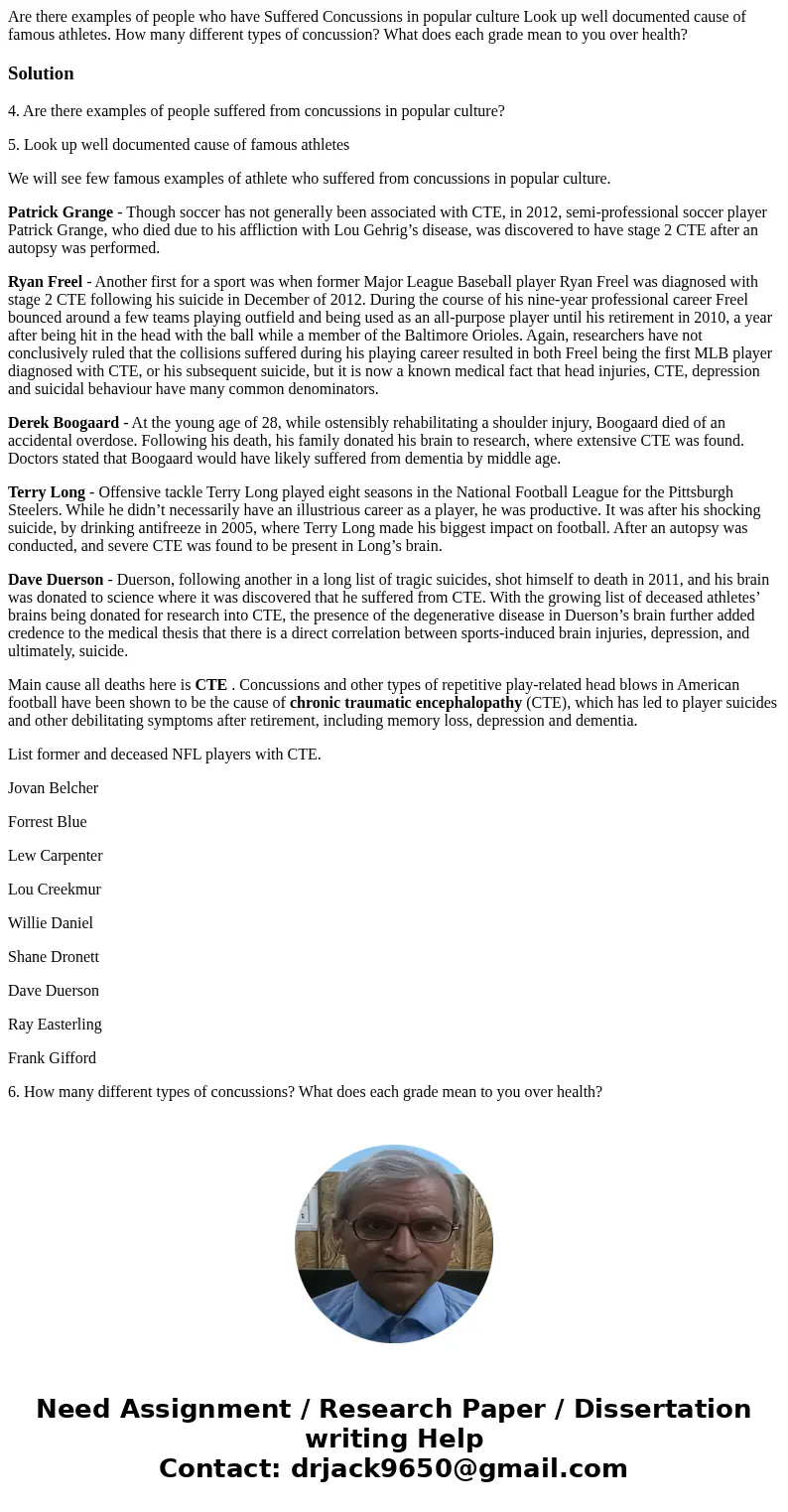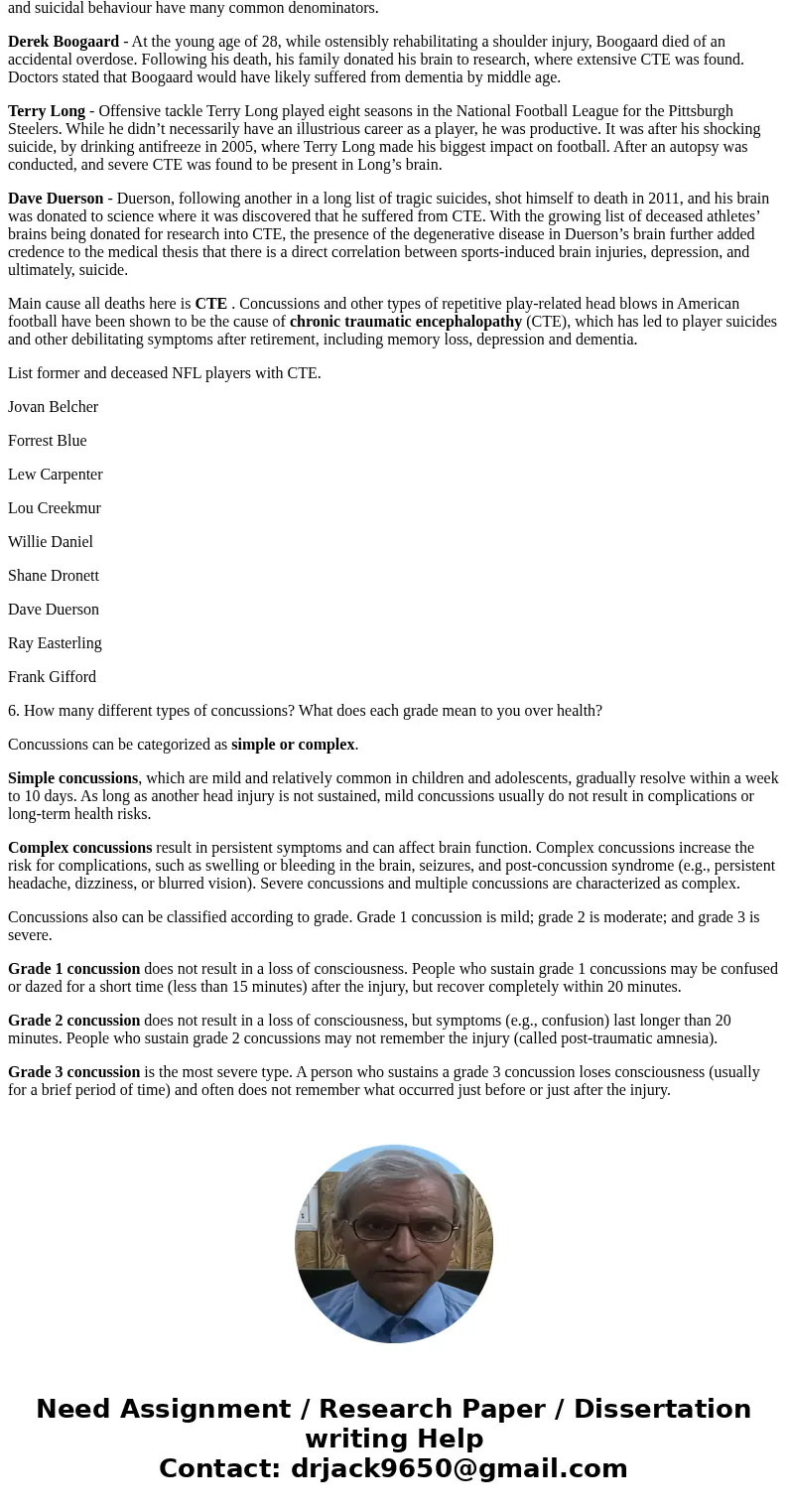Are there examples of people who have Suffered Concussions i
Solution
4. Are there examples of people suffered from concussions in popular culture?
5. Look up well documented cause of famous athletes
We will see few famous examples of athlete who suffered from concussions in popular culture.
Patrick Grange - Though soccer has not generally been associated with CTE, in 2012, semi-professional soccer player Patrick Grange, who died due to his affliction with Lou Gehrig’s disease, was discovered to have stage 2 CTE after an autopsy was performed.
Ryan Freel - Another first for a sport was when former Major League Baseball player Ryan Freel was diagnosed with stage 2 CTE following his suicide in December of 2012. During the course of his nine-year professional career Freel bounced around a few teams playing outfield and being used as an all-purpose player until his retirement in 2010, a year after being hit in the head with the ball while a member of the Baltimore Orioles. Again, researchers have not conclusively ruled that the collisions suffered during his playing career resulted in both Freel being the first MLB player diagnosed with CTE, or his subsequent suicide, but it is now a known medical fact that head injuries, CTE, depression and suicidal behaviour have many common denominators.
Derek Boogaard - At the young age of 28, while ostensibly rehabilitating a shoulder injury, Boogaard died of an accidental overdose. Following his death, his family donated his brain to research, where extensive CTE was found. Doctors stated that Boogaard would have likely suffered from dementia by middle age.
Terry Long - Offensive tackle Terry Long played eight seasons in the National Football League for the Pittsburgh Steelers. While he didn’t necessarily have an illustrious career as a player, he was productive. It was after his shocking suicide, by drinking antifreeze in 2005, where Terry Long made his biggest impact on football. After an autopsy was conducted, and severe CTE was found to be present in Long’s brain.
Dave Duerson - Duerson, following another in a long list of tragic suicides, shot himself to death in 2011, and his brain was donated to science where it was discovered that he suffered from CTE. With the growing list of deceased athletes’ brains being donated for research into CTE, the presence of the degenerative disease in Duerson’s brain further added credence to the medical thesis that there is a direct correlation between sports-induced brain injuries, depression, and ultimately, suicide.
Main cause all deaths here is CTE . Concussions and other types of repetitive play-related head blows in American football have been shown to be the cause of chronic traumatic encephalopathy (CTE), which has led to player suicides and other debilitating symptoms after retirement, including memory loss, depression and dementia.
List former and deceased NFL players with CTE.
Jovan Belcher
Forrest Blue
Lew Carpenter
Lou Creekmur
Willie Daniel
Shane Dronett
Dave Duerson
Ray Easterling
Frank Gifford
6. How many different types of concussions? What does each grade mean to you over health?
Concussions can be categorized as simple or complex.
Simple concussions, which are mild and relatively common in children and adolescents, gradually resolve within a week to 10 days. As long as another head injury is not sustained, mild concussions usually do not result in complications or long-term health risks.
Complex concussions result in persistent symptoms and can affect brain function. Complex concussions increase the risk for complications, such as swelling or bleeding in the brain, seizures, and post-concussion syndrome (e.g., persistent headache, dizziness, or blurred vision). Severe concussions and multiple concussions are characterized as complex.
Concussions also can be classified according to grade. Grade 1 concussion is mild; grade 2 is moderate; and grade 3 is severe.
Grade 1 concussion does not result in a loss of consciousness. People who sustain grade 1 concussions may be confused or dazed for a short time (less than 15 minutes) after the injury, but recover completely within 20 minutes.
Grade 2 concussion does not result in a loss of consciousness, but symptoms (e.g., confusion) last longer than 20 minutes. People who sustain grade 2 concussions may not remember the injury (called post-traumatic amnesia).
Grade 3 concussion is the most severe type. A person who sustains a grade 3 concussion loses consciousness (usually for a brief period of time) and often does not remember what occurred just before or just after the injury.


 Homework Sourse
Homework Sourse